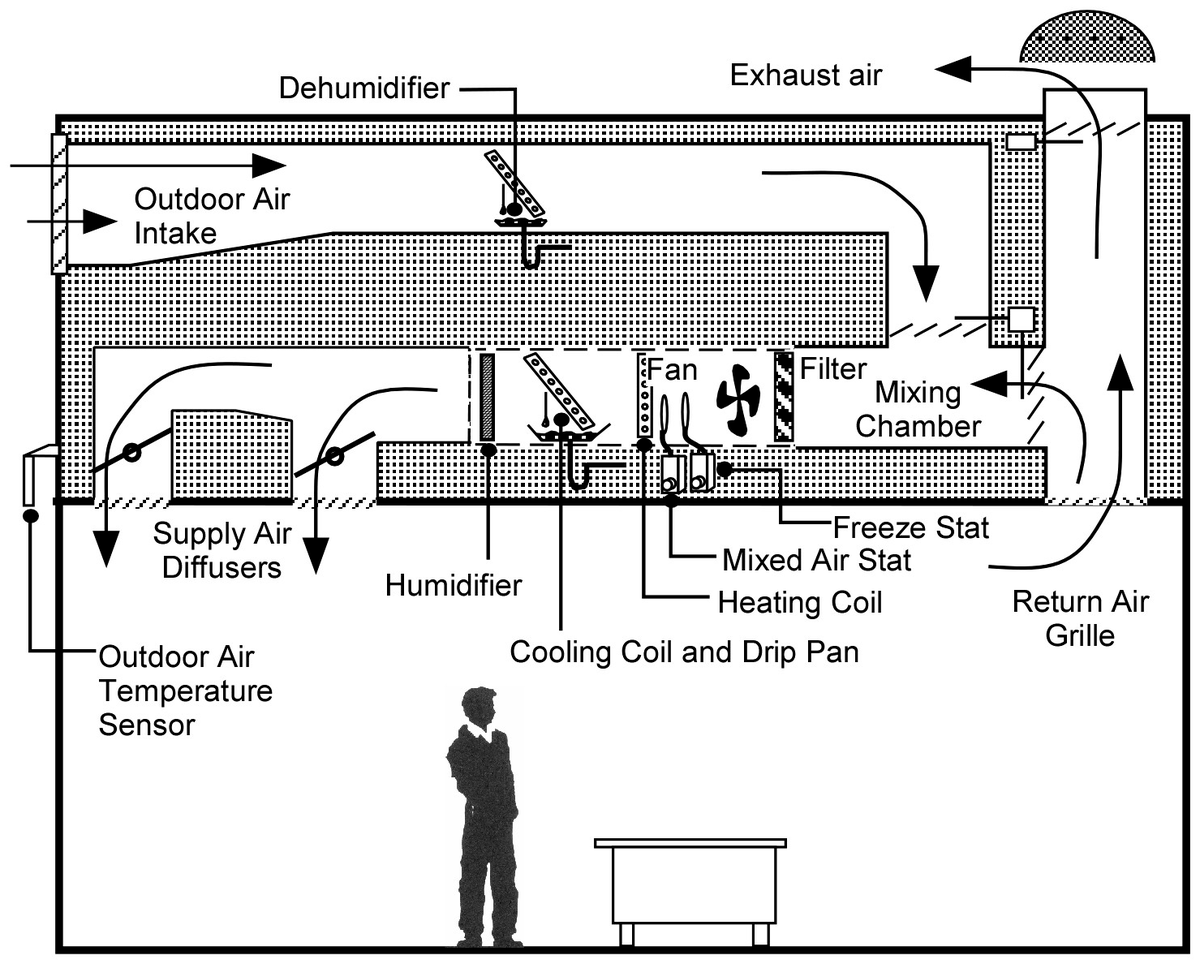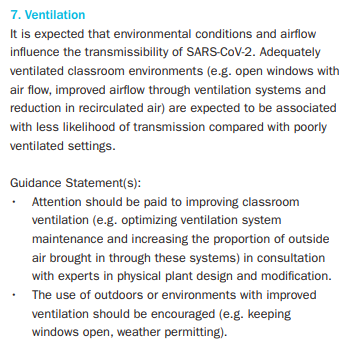This is a bad idea to try on Twitter but here goes. But first some caveats:
1) I& #39;m going to work off of US standards because I don& #39;t have a copy of CSA Z317.2-19, had to learn US standards for a test once, and they explain Harvard& #39;s recommendations better. https://twitter.com/PHealthGnome/status/1289606299265703936">https://twitter.com/PHealthGn...
1) I& #39;m going to work off of US standards because I don& #39;t have a copy of CSA Z317.2-19, had to learn US standards for a test once, and they explain Harvard& #39;s recommendations better. https://twitter.com/PHealthGnome/status/1289606299265703936">https://twitter.com/PHealthGn...
2) While I have reviewed and consulted on HVAC systems, this is by no means what I usually do. There are people with a lot more technical knowledge on this topic.
3) I& #39;m trying to keep this simple.
With that over, this is an HVAC system.
3) I& #39;m trying to keep this simple.
With that over, this is an HVAC system.
In general, when we talk about IPAC concerns around HVAC systems we are looking at TB and moulds (aspergillus usually). Yes we are concerned about Legionella but that& #39;s more of a water safety item. What we aren& #39;t that concerned about is our traditional droplet spread diseases.
We are mainly concerned with the following HVAC parameters in healthcare settings:
1) Air exchange rate
2) Fresh air mixture
3) Humidity
4) Filtration
5) Pressure differentials
1) Air exchange rate
2) Fresh air mixture
3) Humidity
4) Filtration
5) Pressure differentials
1) Air exchange rate is how often the air in a room turns over. I& #39;m going to use Air Changes Per Hour or ACH. Patient rooms should be above 6 ACH, waiting rooms 12, and procedure rooms 15.
As a general rule, this decreases over time as the system breaks down.
As a general rule, this decreases over time as the system breaks down.
2) Fresh air mixture is how much of the air is fresh vs re-circulated. Fresh air is better for air quality, but it takes a lot of energy to condition that air to the proper temperature and humidity. In general you want about 2ACH to be from fresh air if possible.
I really want to stress that air exchange rate and fresh air mixture go hand in hand. They work together to dilute any pathogens in the air, they also work wonders for improving comfort. They keep your CO2 levels down, and make everyone happy.
3) Humidity- Too low and you increase respiratory virus transmission, too high and you get mould growth. 30-60%. It can also compromise the sterility or autoclaved items. Maybe I shouldn& #39;t have included this one but it is in my picture!
4) Filtration- We mainly have filtration in place to filter out mould. I& #39;m going to use MERV. Inpatient care should be 2 beds of MERV 8 then MERV 14. A hospital lab is one bed of MERV 13, general areas are 1 bed of MERV 8.
But what about HEPA? Technically that& #39;s just anything in the MERV 17-20 range. They& #39;re only really needed if
a) You have a protective environment setup
or
b) You are trying to MacGyver an airborne isolation room without negative pressure.
a) You have a protective environment setup
or
b) You are trying to MacGyver an airborne isolation room without negative pressure.
Filtration is only really important if you suspect that something can make its way through all the bends, baffles, and fans within your HVAC system. i.e. If it is truly airborne.
COVID is not airborne. It might have hang time, and that& #39;s different.
COVID is not airborne. It might have hang time, and that& #39;s different.
5) Pressure differentials- Air flows from high pressure to low pressure. You can artificially create a pressure gradient to control air movement. Positive pressure will prevent outside air from entering a room and negative pressure to keep air from entering surrounding areas.
In general we want air moving from clean to dirty areas, but we only get super picky in certain areas. When we have an airborne disease, we want those patients in a negative pressure room. Pressure gradients are tricky and open/closing doors and windows can mess things up.
But what about COVID? Harvard had a lot of pages on HVAC systems!
Technically, it looks like Harvard just copied the ASHRAE guidance (from May) for building operations during the COVID-19 Pandemic. Not a bad group to copy from but I think they& #39;re wrong.
https://www.ashrae.org/file%20library/technical%20resources/ashrae%20journal/2020journaldocuments/72-74_ieq_schoen.pdf">https://www.ashrae.org/file%20li...
Technically, it looks like Harvard just copied the ASHRAE guidance (from May) for building operations during the COVID-19 Pandemic. Not a bad group to copy from but I think they& #39;re wrong.
https://www.ashrae.org/file%20library/technical%20resources/ashrae%20journal/2020journaldocuments/72-74_ieq_schoen.pdf">https://www.ashrae.org/file%20li...
Their guidance includes a lot of filtration and even considers UV disinfection. It is based on the assumption that the virus is able to re-circulate within the HVAC system. COVID IS NOT AIRBORNE!
Any HVAC system is going to knock droplets out of the air.
Any HVAC system is going to knock droplets out of the air.
Shout out to Alberta Health Services for producing high quality knowledge products on COVID-19. Here is one on the role of HVAC systems in COVID-19 spread.
Spoiler alert: It can& #39;t spread through HVAC systems.
https://www.albertahealthservices.ca/assets/info/ppih/if-ppih-covid-19-sag-risk-transmission-hvac-systems-rapid-review.pdf">https://www.albertahealthservices.ca/assets/in...
Spoiler alert: It can& #39;t spread through HVAC systems.
https://www.albertahealthservices.ca/assets/info/ppih/if-ppih-covid-19-sag-risk-transmission-hvac-systems-rapid-review.pdf">https://www.albertahealthservices.ca/assets/in...
So what is the role? Well we do know that there is the potential for COVID-19 to hang around in enclosed air spaces for a while.
I am very impressed with this article by Lieu et al. They found that areas with higher ACH had lower levels of COVID. https://www.nature.com/articles/s41586-020-2271-3">https://www.nature.com/articles/...
I am very impressed with this article by Lieu et al. They found that areas with higher ACH had lower levels of COVID. https://www.nature.com/articles/s41586-020-2271-3">https://www.nature.com/articles/...
They also found that toilet rooms had bad air quality. If you see a recommendation to make washrooms negative pressure, it likely cites this article.
So what should we do about HVAC systems? Increase your ventilation rate and increase your fresh air mixture. Dilute any pathogens in the air and usher them out of enclosed spaces. Most schools don& #39;t have fancy HVAC systems, but if they do you can adjust them.
Thankfully, there is a low-cost solution that many schools have access to: Windows.
I bet the Sick Kid guidance on ventilation makes a bit more sense now. I& #39;d have fallen on the same guidance based on the available evidence.
I bet the Sick Kid guidance on ventilation makes a bit more sense now. I& #39;d have fallen on the same guidance based on the available evidence.
If you& #39;re curious about fans and window box air conditioners, PHO has a paper on them:
https://www.publichealthontario.ca/-/media/documents/ncov/ltcrh/2020/08/covid-19-fans-air-conditioning-ltcrh.pdf?la=en">https://www.publichealthontario.ca/-/media/d...
https://www.publichealthontario.ca/-/media/documents/ncov/ltcrh/2020/08/covid-19-fans-air-conditioning-ltcrh.pdf?la=en">https://www.publichealthontario.ca/-/media/d...
Back in April, I had a very colourful conversation with a gentleman who had read about HVAC systems on facebook and was demanding we disable them in nursing homes. That would have been a bad idea.
In conclusion:
I& #39;m not concerned about filtration or purification, I& #39;m concerned about air flow. Public buildings should forget the heating budget and keep windows open as long as they can. If they have an outdoor exhaust fan in the washroom, turn it on.
I& #39;m not concerned about filtration or purification, I& #39;m concerned about air flow. Public buildings should forget the heating budget and keep windows open as long as they can. If they have an outdoor exhaust fan in the washroom, turn it on.
The guidance to do AGP in a negative pressure room is sound, but beyond that I am not concerned about pressure differentials when it comes to COVID.
Trying this on twitter was likely a bad idea.

 Read on Twitter
Read on Twitter




